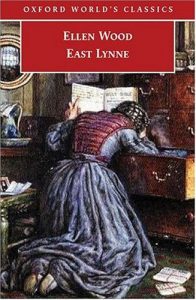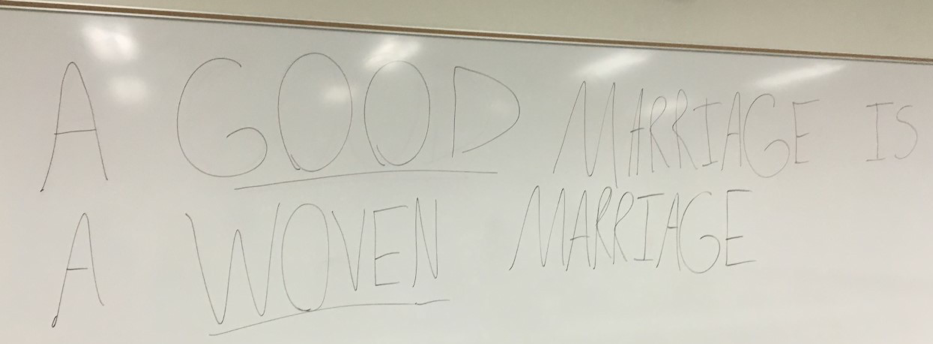My English 1102 class, “Odd Victorian Bodies,” uses the lens of nineteenth-century British literature to study the concepts of multimodal–or WOVEN (written, oral, visual, electronic, and nonverbal)–communication. The class reads Victorian novels, short stories, and poetry that deal explicitly with bodies. In addition to learning about a historical time period, its literature, and its sociocultural construction of bodies, students study rhetoric, process, and various facets of multimodal communication. The subject of bodies especially enhances our ability to discuss nonverbal communication, as students constantly notice how the bodies and body language of characters in the works we read impact their communication and relationships with others.
Most recently, we read Ellen Wood’s 1861 sensation novel East Lynne. This novel is centered around the fictional English countryside town of West Lynne, and the inhabitants of the neighboring estate of East Lynne. In the first half of the novel, Archibald Carlyle, the novel’s hero, marries the young, beautiful, but financially destitute Lady Isabel Vane. Isabel’s background–she grew up motherless, isolated from other children with only a governess to educate her–has ill prepared her for marriage; she knows nothing about matters like housekeeping, overseeing servants, or managing a household budget. Further complicating matters is Carlyle’s domineering, spendthrift sister Cornelia, who insists on living with her brother and his young wife. Cornelia constantly reprimands Isabel for purchasing what she deems as extravagant luxuries, although Isabel is actually fairly modest in her expenditures. Unfortunately for Isabel, her husband is blind to her struggles as a wife, never realizing that she is the subject of Cornelia’s constant wrath.

Image via http://www.goodreads.com/book/show/1109858.East_Lynne.
About halfway through the novel, the marriage between Carlyle and Isabel quickly begins to unravel. Isabel exhibits poor oral communication skills; her passivity often prevents her from telling her husband of her troubles at all, and when she does, she doesn’t articulate her points clearly, so he regularly underestimates the severity of her concerns. Meanwhile, Carlyle is inept at reading nonverbal cues. He takes everything Isabel says at face value, so when she gets frustrated with his inability to understand her complaints, she often resorts to saying that everything is fine, while outwardly demonstrating that it is not. Carlyle misses every nonverbal signal Isabel gives him–looks of frustration or depression, a low-hanging head, a hesitance or refusal to take his hand, turning her body away from his–and their combined poor communication ultimately leads to a major misunderstanding that spells disaster for the entire family: Isabel, in a moment of passionate anger, abandons her husband and children and flees in the middle of the night with another man.
When our class discussed the scene in which Isabel leaves, students grappled with their different feelings about the decision in attempt to articulate their responses. While reading previous chapters, students had expressed frustration with Carlyle for being so blind to Isabel’s obvious complaints, while most of them were only mildly frustrated with Isabel for unclearly articulating her needs. When the tides turned quickly and Isabel became the character clearly in the wrong, many students expressed anger, and they tried to rationalize her decision in attempt to feel less frustrated with it. Working our way through the scenes that led up to this event afforded the class a great opportunity to discuss communication–what was said, what wasn’t said, what body language suggested, what was written–to try to understand each character’s perspective. In the middle of this discussion, two students, Brighton and Andrew, started chatting with one another, when Brighton suddenly jumped up and began searching for a dry erase marker. In our small honors class, students recognizes their own agency as teachers and learners, and I welcome such seeming interruptions from students, as they always lead to interesting and thoughtful contributions. As such, the discussion continued as Brighton searched for a marker, until he had written in giant letters on the whiteboard, “A good marriage is a WOVEN marriage.”

Brighton writes that “A Good Marriage is a WOVEN Marriage.” Photograph courtesy of the author.
In addition to providing the class with a good laugh, this phrase afforded the opportunity to discuss multimodal communication not only within our text and within our classroom, but within life beyond Georgia Tech. I asked Brighton and Andrew about the phrase, and in the section below, they discuss WOVEN concepts in terms of classroom, extracurricular, and personal experience, demonstrating how the learning outcomes of English 1102 facilitate communication in the college classroom and beyond.
How did you first come up with the statement, “A good marriage is a WOVEN marriage,” and what were your intentions in writing it on the board?
It was an accurate yet funny representation of the flawed relationship between Carlyle and Isabel in Ellen Wood’s East Lynne. The intention of writing it on the board was to give following classes that day something to ponder and to enjoy.
How would the plot of East Lynne have differed had Isabel and Carlyle each had stronger WOVEN communication skills?
The marriage between them would have improved because communication would have bolstered Isabel’s confidence, allowing her to overcome her suspicions and insecurities. Had the couple used more WOVEN communication skills during their marriage, the odds are that Isabel would have never been deceived into leaving Carlyle. The plot would have lacked the driving problem of the novel and led to happier versions of both Carlyle and Isabel.
How do the stylistic elements of your writing (capitalization, underlining, etc.) impact the way your classmates interpreted your point?
By writing the statement in all caps, we emphasize its importance and draw eyes towards it. Furthermore, by underlining the words “good” and “WOVEN,” we highlight the correlation between the two, that indeed WOVEN communication is good communication.
In what ways does WOVEN communication impact your interpersonal relationships in small honors college classrooms?
Just as WOVEN communications are essential to a marriage — Carlyle and Isabel’s marriage is doomed without it — these communication skills are the cornerstone to our class. Without clear communication through all modes, it is impossible to form strong, effective relationships with classmates and teachers both inside and outside of class.
How do you see WOVEN communication impacting your own life outside of the classroom, both now and in the future?
WOVEN communication is, in short, all forms of communication. Whether it’s negotiating at a job interview, proposing to the love of my life, or cheering on our favorite team at the Saturday game, we are engaging in WOVEN communication. Having a firm understanding and competence in WOVEN communication improves our lives and provides us the means by which we can improve those of others.
The larger connection these students drew from our in-class work enabled students to grasp, in a humorous but specific way, how the subjects we cover in the first-year-writing classroom transfer to life both at and beyond Georgia Tech. In Brighton and Andrew’s own words, “WOVEN communication is, in short, all forms of communication.” When we communicate with someone, be it through a formal presentation, a job interview, or via email, our audience derives meaning from more than just our words. When Brighton and Andrew communicate with their classmates, their peers notice not only their words, but their body language, facial expressions, vocal tone, physical proximity to the people they’re speaking with–all of these elements impact their relationships with their peers. After Georgia Tech, in a job interview, for instance, facial expressions, pacing of speech, and vocal inflection will be integral to keeping their listener’s active attention; the content of the words they speak only matter if other forms of communication work effectively with their words. As Andrew and Brighton have shown us, unpredictable, blink-and-you-miss-them classroom moments can remind us that WOVEN communication impacts our lives and relationships daily.
Brighton Ancelin, from Florida, plans to major in Electrical Engineering and develop devices for growing industries.
Andrew Dinka, a native of New Jersey, intends to major in Mechanical Engineering and to minor in Spanish.
